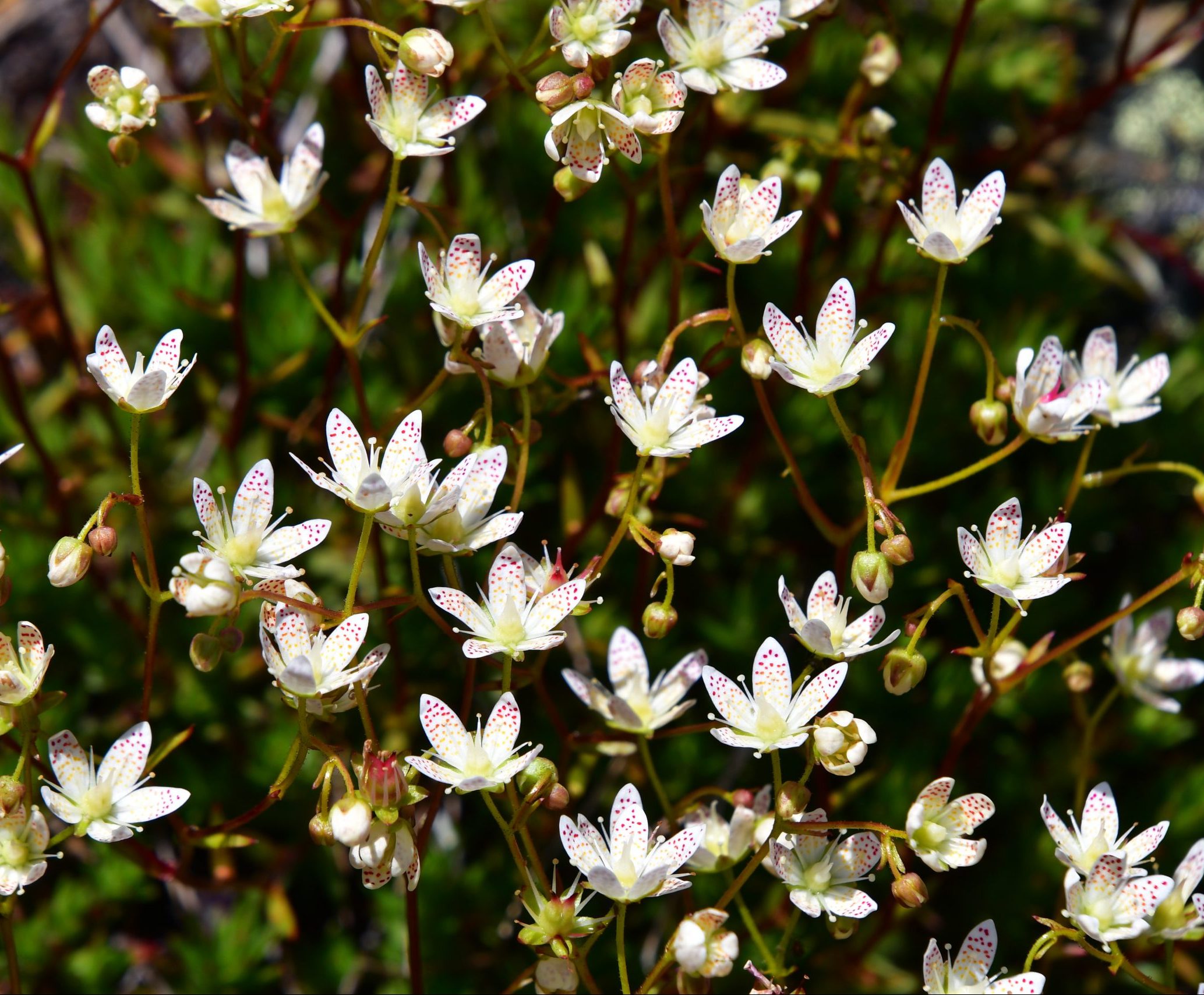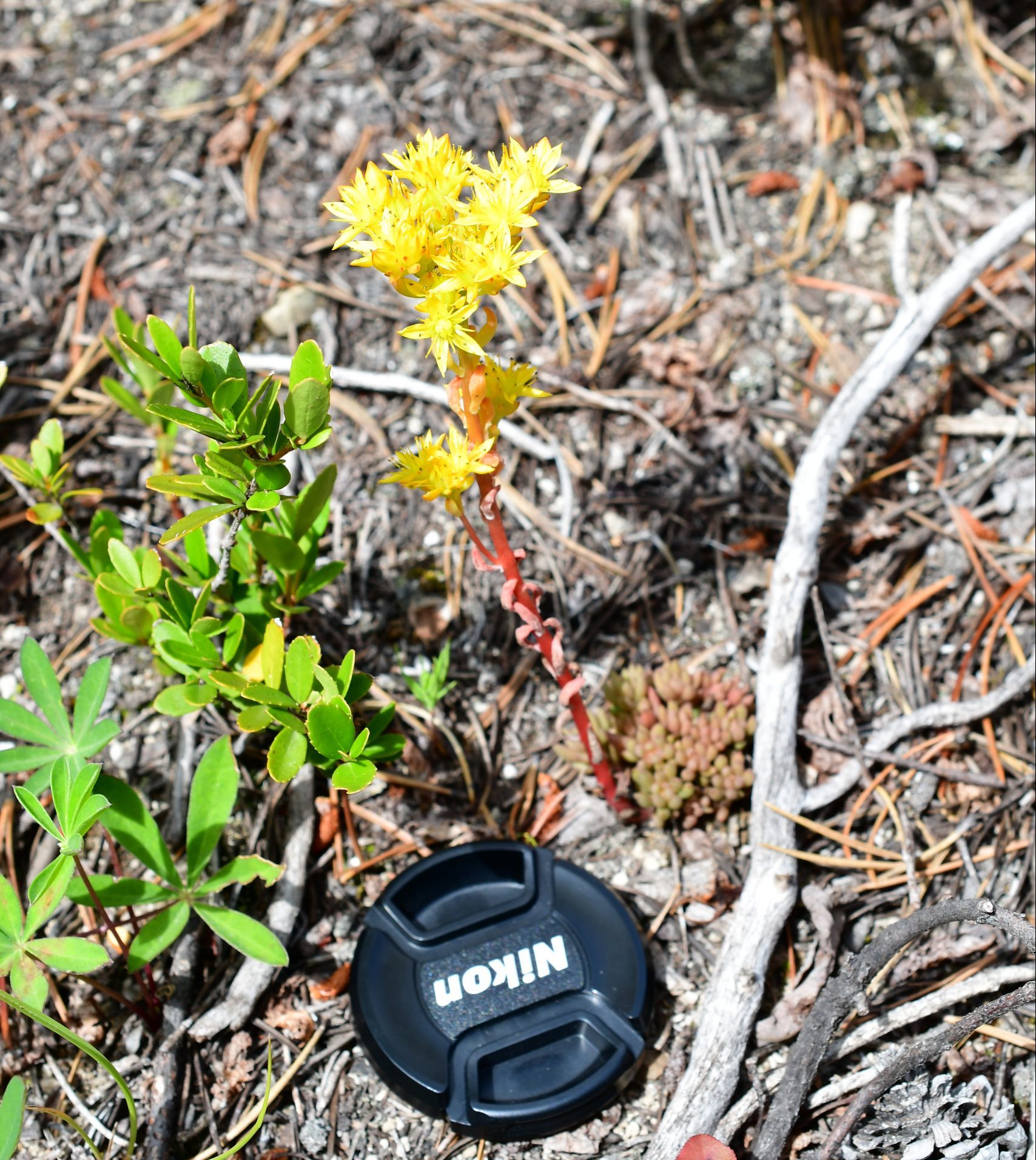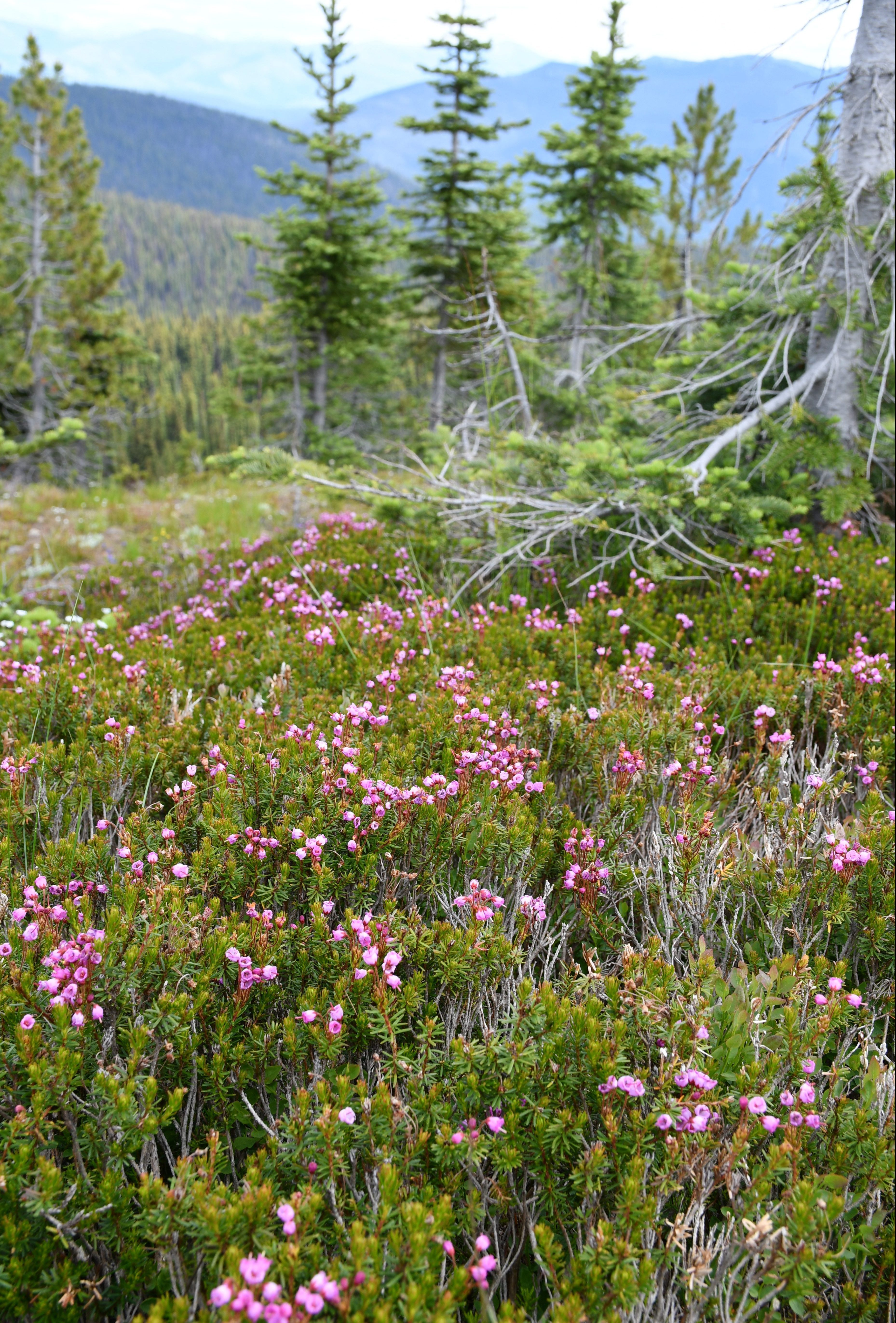Alpine environments such as those occurring above 1800-2000 m in southern BC are characterized by their short growing seasons, deep, long-lasting snowpacks (particularly in coastal ranges), high winds above treeline and low temperatures. Even in summer, temperatures may be cold at night, while during the day, strong sun exposure and water limitation are common, especially on steeply sloping, south-facing aspects. Alpine plant species have adapted to these conditions with characteristics that include those discussed below *. Further, since arctic environments share many of the same environmental conditions as those found in alpine areas, the adaptations discussed may be considered to be features of both arctic and alpine environments.
* Additional readings are provided at the end of this page for students wishing to find out more.
Cushion or mat forming plants

Cushion plants are low growing and compact plant species (Mackenzie 2006). Their short and compact stature enables them to avoid the harsh alpine winds, and water loss that accompanies high winds. Additionally, this adaptation allows the plant to trap heat in the winter, and cool air in the summer (Lütz 2012). The compact form also limits water lost through transpiration, and sunlight absorbed by the plant. Examples of cushion or mat forming plants are Silene Acaulus (Moss Campion), Phlox diffusa (Spreading phlox, see below), and Dryas octopetala (White mountain avens).
Watch this video about the quintessential cushion plant, Moss campion, narrated by Royal BC museum plants curator, Ken Marr:

Rosette form

While the cushion form is a pronounced evolutionary response to the alpine environment, many non-cushion-forming plants exhibit the small stature and high stem densities, and a “rosette” growth form. Examples of rosette plants are Saxifraga crustata (Silver saxifrage), Saxifraga (e.g., Spotted saxifrage, right photo), Sedum lanceolalum (Lance-leaved stonecrop), and Soldonella minima (Alpine snowbell). Similar to the cushion adaptation, the low, ground-hugging rosette protects plants from high wind, helping them to maintain higher plant temperatures in winter and reduce water loss year-round (Lütz 2012; Mackenzie 2006; Streb et al. 2020).
Fine leaf and stem hairs
Some alpine plants have fine hairs or “fuzz” on their leaves and stems. Note the frequency with which alpine and arctic plant taxa have a species adjective “hirsute/hirsuta”, translated as “hairy”, e.g., Pedicularis hirsuta, a species of the Canadian Arctic. This adaptation protects against strong winds prevalent in open expanses above arctic/alpine treeline. It further enables the plants to retain warmer air even under relatively still conditions. Finally, it allows the plant to capture and retain moisture, otherwise lost through transpiration and the surrounding air (Mackenzie 2006). Examples of plants with this adaptation are species of Potentilla (Cinquefoil), Antennaria lanata (Woolly pussytoes, photo to right) Lupinus arcticus (Arctic Lupine), and Phacelia tanacetifolia (Lacy phacelia).

Dwarf shrubs:
The dwarf shrub plant adaptation is similar to the cushion plant adaptation, due to its low and dense structure. This structure protects the plant from winds, creates a warmer microclimate at the base of the plant in winter, and cooler microclimate in summer (Gehrk et al. 2016). This adaptation also enables higher survival rates of seedlings due to the protection that the plant provides (Gehrk et al. 2016). Due to this smaller than usual stature, less energy is used by the plant to form photosynthetic tissues, and therefore less resources are required to satisfy the plant (Streb et al. 2020). Examples of this adaptation are, in the Himalayas: Cassiope fastigiata (Himalayan heather): In North America including BC: Vaccinium gaultherioides (Bog bilberry), and Empetrum hermaphroditum (Mountain crowberry).
Implications for ecosystem structure: Considered together, the tendency toward cushion, mat, rosette and dwarf shrub forms points to an environment in which the physical, rather than biotic, conditions are limiting; rather than competition, cooperation and high densities are advantageous. In the high alpine zone, there is strength in numbers!
Bare rock and frosty ground colonists:
Some species in the alpine require very little and undesirable soil to grow. These plants can colonize on boulder surfaces, and frost covered ground (Mackenzie 2006). Examples of these are lichens, liverwort, and moss. See the photos of Elegant sunburst lichen along the south ridge of our Alpine VR S Chilcotins tour.
Tussock grasses and sedges:
Grasses and sedges are common in the high alpine areas, in wet meadows to exposed rocky slope. Some of these taxa have a growth form that is similar to cushion plants and equally protective — low stature and compact form. Tussock species have long leaves that bend over to further protect the plant base from wind damage, and promote heat retention (Körner 2003). Other plants that grow near these grasses may also use the grass’ structure to protect themselves (Ezcurra & Gavini 2009). Examples include Festuca brachyphylla (Alpine fescue), Carex nigiricans (Black alpine sedge), and Phleum alpinum (Alpine timothy).
Evergreen foliage:
Being evergreen is a useful adaptation among alpine and subalpine species. Pink and white mountain heather are examples of evergreen shrubs in the alpine. Many of the dominant tree species of the lower alpine / subalpine transition zone are also examples, including the conifer Spruce engelmannii (Engelmann spruce) and Subalpine fir (Abies lasiocarpa). At lower elevations, within the subalpine zone, common evergreens include Pseudotsuga menziesii (Douglas fir) and Tsuga heterophylla (Western hemlock).

By retaining foliage year-round, these species reduce the energy and time needed to invest annually in new leaves, a clear advantage in places where the growing season is brief, and where evergreen photosynthetic surfaces can fix carbon for even brief periods when temperatures climb above 0 degrees.
Perennial life history:
Being perennial rather than annual is an adaptation that makes living in the alpine more efficient, similar to being evergreen. Perennial plants have a life cycle that occurs over 2 or more years. Even if the plants are deciduous and lose leaves, and sometimes stems, during the winter, they do not need to invest annually in building a root structure, and can leaf out using reserves stored over winter in their roots (Streb et al. 2020). As mentioned in the previous section, some perennial plants retain their leaves and stems (are evergreen) so that they can instantly photosynthesize when the snow cover is removed (Streb et al. 2020). Examples of perennial plants are Ranunculus glacialis (Glacial buttercup), Soldanella alpine (Alpine snowbell), and Geum montanum (Alpine avens).
Root investment:
In general, alpine plant species may have much shallower roots, due to thin rocky soils in many alpine areas. However, over their life cycle, alpine plants commonly invest in a greater root system than at lower altitudes, due to perennial growth forms and less favourable above ground conditions. As such, more energy is invested into the roots, and less in the above ground plant (Humphries 2020). This results in a large root to shoot ratio. Additionally, at higher elevations, plants are found to have shared root systems with positive interactions between them (Ma et al. 2015).
References and Further Reading:
BC Min of Forests and Range. 2006. The ecology of the alpine zones. Brochure Available online at: https://www.for.gov.bc.ca/hre/becweb/Download/Downloads_SubzoneReports/IMA.pdf
Ezcurra, C. & Gavini, S. S. 2019. Alpine plant diversity in temperate mountains of South America. In: Reference Module in Earth Systems and Environmental Sciences. https://doi.org/10.1016/B978-0-12-409548-9.11906-2.
Gehrk, B., Kandziora, M., Pirie, D. M. 2016. The evolution of dwarf shrubs in alpine environments: a case study of Alchemilla in Africa. Annals of Botany, 117(1), 121-131. https://doi.org/10.1093/aob/mcv159.
Humphries, H. C. 2020. Alpine ecosystems in temperate mountains of North America. In: Reference Module in Earth Systems and Environmental Sciences. https://doi.org/10.1016/B978-0-12-409548-9.12452-2.
Körner, C. 2003. Alpine plant life: functional plant ecology of high mountain ecosystems. Springer-Verlag Berlin Heidelberg
Lütz, C. 2012. Plants in alpine regions. Springer-Verlag Wien.
Ma, L., X. Sun, K. Xiangxiang, J. Valero-Galván, X. Li, S. Yang, Y. Yang, X. Hu. 2015. Physiological, biochemical and proteomics analysis reveals the adaptation strategies of the alpine plant Potentilla saundersiana at altitude gradient of the Northwestern Tibetan Plateau. Journal of Proteomics, 112, 63-82. https://doi.org/ 10.1016/j.jprot.2014.08.009.
Mackenzie, W. 2006. The ecology of the alpine zones. Retrieved from: https://www.for.gov.bc.ca/hre/becweb/Downloads/Downloads_SubzoneReports/IMA.pdf
Royal BC Museum. Alpine plants: What can you learn about BC’s environmental history from alpine plants? Retrieved from: https://learning.royalbcmuseum.bc.ca/pathways/alpine-plants/ . Includes links to short audio clips narrated by plants curator, Ken Marr:
Alpine Environments: https://soundcloud.com/royalbcmuseum/zoom0056wav
Alpine adaptations: https://soundcloud.com/royalbcmuseum/zoom0059wav
Streb, P., Cornic, G., Bligny, R. 2020. How do plants cope with alpine stress? Encyclopedia of the Environment, Retrieved from https://www.encyclopedie-environnement.org/en/life/how-do-plants-cope-with-alpine-stress/.
Hewitt, N. and Ballon, E. 2020, CC-BY-NC-SA 4.0.
Financial support for this project provided by UBC Vancouver students via a Teaching and Learning Enhancement Fund Grant (to NH).


